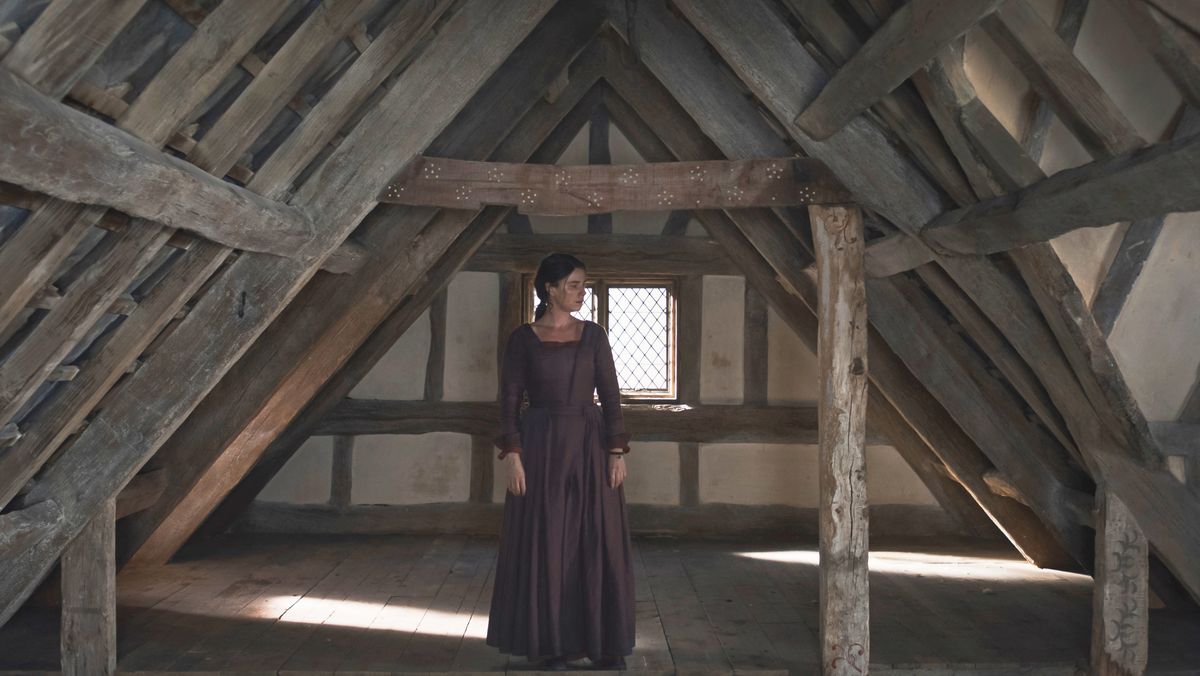“Tell me a story,” the earthy young woman asks the shy Latin tutor early in Chloé Zhao’s “Hamnet.” What story, he asks? “Something that moves you.”
She’s made a shrewd choice of storyteller. This awkward young man seems to have a way with words as he recounts the tragic myth of Orpheus and Eurydice. As well he should: One day he’ll be known as the finest wordsmith in the world.
But Agnes, though being wooed by William Shakespeare himself, doesn’t have the same relationship with words, nor need for them. Unlike her bookish suitor, her mystical nature — some say her mother was a forest witch! — and appetite for life lend her ready access to a seemingly volcanic array of emotions, from giddy joy to unfathomable grief, all at the tips of her earth-soiled fingers.
And volcanic is the best way to describe Jessie Buckley’s startling performance in “Hamnet,” Zhao’s unabashedly emotional adaptation of Maggie O’Farrell’s acclaimed novel. Also starring a magnetic Paul Mescal as Will, it’s a story that imagines the early life of the young couple from Stratford. And as O’Farrell’s readers know, it centers on a life-altering loss: the death of their 11-year-old son, Hamnet.
You may have heard that early viewings of the film left swaths of the audience in tears. Spoiler alert: This is no surprise. Zhao, co-writing with O’Farrell, goes straight for the tear ducts, with crucial help from a superb cast led by Buckley — who, like her character, seems to have an extraordinary ability to dispense with artifice and access a wildness simmering beneath the surface. We’d tell you to watch her face during the riveting conclusion, where she’s part of a large crowd. But really, your eyes won’t go anywhere else.
So we begin with a heady love story, soon to be tested. “Love doesn’t die, it transforms,” Zhao has said. Her first task is to show how even the sturdiest love can be transformed by grief.
But of course, there’s another act. In “Hamnet,” love is transformed by grief and then transformed again, by art. Which art, you ask? Well, that’s obvious from the title. The play’s the thing.
Speaking of “Hamlet,” a crucial fact is laid out at the very start: In 16th-century England, the names “Hamnet” and “Hamlet” were interchangeable.
Scholars also know that Shakespeare and his wife, Anne Hathaway (also called Agnes), indeed had a son named Hamnet who died at 11. Little else is known, including how he died or what — if any — connection there was to the creation, a few years later, of what many call the greatest play in the English language. A play, it bears noting, about untimely death and grief.
Author O’Farrell, of course, imagines a deep connection. The movie stays largely faithful to her book but changes its structure, moving chronologically rather than toggling between time periods.
It starts with a vision of Agnes, curled in a tree hollow as if born there. No wonder Will is enchanted as he looks out his classroom window and spies this free spirit, whose chief companion is a hawk. He figures she’s a maid; actually, she’s the eldest daughter of the house where he’s tutoring to fulfill family debts. Their connection is electric. Soon, she’s pregnant.
Agnes will birth their first child, a daughter, alone in nature, clinging to tree branches. (Cinematographer Łukasz Żal makes especially deft use of light and lush foliage). A few years later, when she gives birth again, Will’s stern mother (Emily Watson) insists she stay inside. She delivers twins — a boy, then a girl who at first seems stillborn, but is revived by mother’s touch.
Still, Agnes is terrified, because she’s had a vision of two children — not three — at her deathbed. Meanwhile, Will is spending much time in London, pursuing business opportunities and, then, his theater ambitions. Agnes herself encouraged the move. But that changes when Hamnet (Jacobi Jupe, nobly endearing), who promised his father he’d look after everyone, takes ill.
When he succumbs, Agnes falls into inconsolable grief. And when a devastated Will comes home, she matter-of-factly explains how, no, he has actually no idea what it was like. “You weren’t here,” she says coldly. If he had been, he could have said goodbye.
But soon Will must leave again. He’s working on a play. We see early rehearsals of “The Tragedie of Hamlet,” and at one point Mescal — frustrated with his players — shows his Shakespearean chops with an angry rendition of the “Get thee to a nunnery!” speech. (Side note: If all this leads to Mescal playing Hamlet someday in a theater somewhere, we’re here for it.)
The mastery of these words, and their delivery, contrast starkly with Agnes’ most impactful scenes, which often occur with few or no words at all. We’ve already alluded to the walloping conclusion, where love, grief and art all converge in the film’s most powerful moment. To watch Buckley here is to appreciate that even in a story about Shakespeare, it can be the gaps between words that resonate profoundly.
So, yes, watch Agnes’ face as she listens. The famous words coming from the stage are only part of the equation. The rest — OK, we’ll say it — is silence.
“Hamnet,” a Focus Features release, has been rated PG-13 by the Motion Picture Association “for thematic content, some strong sexuality, and partial nudity.” Running time: 125 minutes. Three and a half stars out of four.
By JOCELYN NOVECK
AP National Writer





